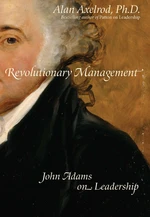A prime mover and key architect of American independence, collaborator in the creation of America's first armyâand the man who nominated George Washington as that army's commanderâas well as founder of the U. S. Navy, John Adams negotiated the foreign finance that made the Revolution possible, then negotiated the treaties that ended it in absolute victory. When so many of his countrymen devoted themselves solely to tearing down British tyranny, Adams continually asked and endeavored to answer the question, Then what? He opposed the royal tyranny of kings, but he opposed no less the hyper-democratic tyranny of the mob. He honed and championed a two-chambered Congress, a strong chief executive, and an independent judiciary. As successor to George Washington, he continued to shape the presidency in Washington 's image, seeking, as the first president had sought, to elevate the office above partisan politics. But he was no mere post-Washington caretaker. Controversiallyâand the controversy continues todayâhe acted to stem in America the tide of the French revolution, in which his one-time boon colleague and now archrival Jefferson saw the apotheosis of liberty, but in which Adams saw only anarchy and terror. Adams promoted the Alien and Sedition Acts, legislation intended to stave off destructive French and French-inspired radicalism but also potentially so repressive as to repeal, in effect, much of the American Revolution. Yet Adams was never apologetic about this. âI humbled the French Directory,â he declared late in life, âas much as all Europe has humbled Bonaparte. I purchased navy yards. . . . built frigates, manned a navy, and selected officers with great anxiety and care, who perfectly protected our commerce, and gained virgin victories against the French,â with whom a naval âQuasi Warâ had broken out. At home, President Adams âengaged in the most earnest, sedulous, and, I must own, expensive exertions to preserve peace with the Indians. . . . Not a hatchet was lifted in my time . . . .â On the diplomatic front, the second president, by his own account, âfinished the demarcation of limits, and settled all controversies with Spain . I made the composition [settlement] with England, for all the old Virginia debts, and all the other American debts . . . .â In sum: I had complete and perfect success, and left my country at peace with all the world, upon terms consistent with the honor and interest of the United States , and with all our relations with other nations, and all our obligations by the law of nations or by treaties. . . . I left navy yards, fortifications, frigates, timber, naval stores, manufactories of cannon and arms, and a treasury full of five millions of dollars. This was all done step by step, against perpetual oppositions, clamors and reproaches, such as no other President ever had to encounter, and with a more feeble, divided, and incapable support than has ever fallen to the lot of any administration before or since. No historian would disagree with this self-assessment, the judgment of a man hard on rivals and friends alike, and hardest of all on himself, a man even his bitterest enemies conceded was above all brutally honest and honorable. Yet no United States currency has ever borne the likeness of John Adamsâand, except for the forthcoming series of presidential quarters, on which will be stamped portraits of every American presidentâno coin has ever featured his profile. His birthday has never been celebrated as a national holiday. Among the multitudes of public schools named for presidents and founding fathers, one is hard pressed to find very many John Adams elementary or high schools. Unlike Washington and Jefferson, or the non-presidential founding father Franklin and the latter-day savior of the Union, Lincoln , John Adams has never come to occupy an iconic niche in the American pantheon. Living to his ninety-first year, Adams himself understood that âMausoleums, statues, monuments will never be erected to me.â He believed that Americans would mythologize the Revolution, making of it âone continued lie from one end to the other. The essence of the whole will be that Dr. Franklin's electrical rod smote the earth and out sprung General Washington. That Franklin electrified him with his rodâand thence forward these two conducted all the policy, negotiations, legislatures and war. These . . . lines contain the whole fable, plot, and catastrophe.â From this American mythology, Adams understood he would be excluded. And so he has been. Yet it is within this exclusion that we find the very reasons for the enduring importance of John Adams. He is not, nor ever was, nor ever could be an icon, an image on a dollar bill. He wasâand remains an example ofâa real-world, flesh-and-blood political leader. Those whom we regard as symbols, figures in the great American mythology, are those who heralded, provoked, and brought about revolutionary cha
Price history
Oct 25, 2021
€20.60

